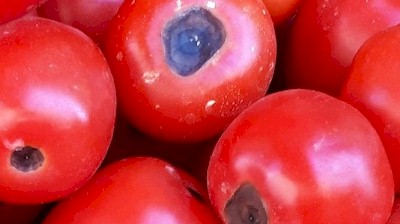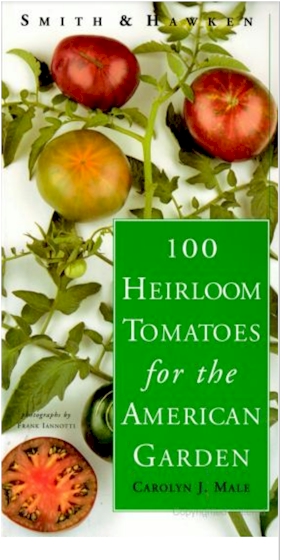Homepage → Gardening Related Topics → Blossom End Rot (BER) in Tomatoes
Blossom End Rot (BER) in Tomatoes
Planted July 27, 2001
Last tended to on October 11, 2024
Reading time: 6 minutes

by Carolyn Male, Ph.D.
Blossom End Rot (BER) is one of the most common tomato problems seen in the early part of the season. It is a physiological condition, not a disease caused by a fungus, a bacterium or a virus. Therefore it cannot be treated. And as I’ll explain below, it is very difficult, if not impossible, to prevent.
BER has nothing to do with the blossoms, it refers to the fact that at the end of the tomato opposite the place where the tomato is attached to the stem, called the stem end, is the bottom of the tomato, which is called the blossom end. You often can see remnants of the blossom attached to that end as the tomato forms. At the blossom end one sees a flattened area that looks leathery and initially brown and then black, as the fruit rots.
BER is said to occur when there is uneven watering, drought, heavy rainfall, excessive nitrogen fertilization, rapid plant growth or root pruning during cultivation, high winds and rapid temperature changes. So lots of conditions have been associated with BER. But the rapid plant growth and nitrogen fertilization are both common to conditions seen early in the season, and indeed, that is when most BER occurs. Then it usually just goes away.
BER occurs because under the conditions just stated, Ca++ moves from the fruit into the vasculature (stems) of the plant. Or, some feel that Ca++ never reaches the fruits because under stress demand for Ca++ exceeds supply. This lowered amount of Ca++ is what causes BER. Excessive rates of transpiration (kind of like sweating in humans) also is involved in Ca++ displacement. Thus, the plant as a whole is NOT Ca++ deficient, the Ca++ has just been displaced. Many books and magazine articles tell you that by adding Ca++ in the form of lime or eggshells, for instance, that you can prevent BER. That does NOT appear to be true. University field trial experiments have so far failed to show that BER can be prevented by addition of Ca++. Peppers and many cole crops are also susceptible to BER and there’s quite a bit of literature on BER and Ca++ for those crops also. The results are the same; addition of Ca++ does not prevent BER.
Some data strongly suggests that foliar spraying with Ca++ is of no use because not enough gets to the fruits to do any good. And it’s known that the sprays for fruits that are sold are useless. No molecules can get across the fruit epidermis. If they did, just what do you think would happen to the fruits when it rained.
Not all varieties of tomatoes get BER. Some never do, others are horrible. That’s not surprising since certainly there are slight physiological differences between varieties. After all, almost all garden tomatoes, with the exception of the currant tomatoes are in the same genus and species, Lycopersicon lycopersicum. And we humans are all in the same species, Homo sapiens, var. sapiens….and look how different some of our physiologies are. Whoa!
So, BER is a physiological condition, cannot be cured, and current literature data suggests it cannot be prevented. It occurs on some, but not all varieties of tomatoes, is usually seen early in the season and then stops, for most folks. It would be nice to say that you could even out your watering, prevent droughts and heavy rainfalls, ensure even and not rapid growth of plants and not disturb the roots by shallow cultivating. But on a practical basis, I think we all know that’s almost impossible. So, BER has never bothered me, I just ignore it, and it goes away with time.
Adding Ca++ to soils that are Ca++ deficient makes sense, but few soils are. And if soils are acidic, Ca++ is not taken up well but addition of Epsom Salts to the soil can aid in Ca++ uptake in such acidic soils.
Many folks add Ca++ and then see that BER disappears. What they fail to realize is that BER is going to go away anyway, as the season progresses. And that’s because as the plants get larger they are better able to handle the many stresses that can induce it. So one cannot correlate addition of Ca++ to disappearance of BER. Universities have done so many studies on this already because BER is a billion dollar problem in the commercial veggie industry.
Of all the stresses that can induce BER the two that are most under control of the home gardener are fertilization and water delivery. That is, too much fertilizer causes plants to grow too rapidly and is perhaps one of the major causes of BER developing. Too rich soils do the same thing. Plant growth simply outstrips the ability of Ca++ to get to the fruits.
Mulching to help ensure even delivery of water can also be done and is also one of the two major causes, in my humble opinion, of BER. BER appears usually on half ripe fruits but also can appear on grass green ones. Lack of Ca++ only occurs at the blossom end of the fruit and it causes tissue destruction which leads to that papery grayish/blackish lesion appearing. Now sometimes that lesion opens up and fungi and bacteria enter and that causes the rotting and also the appearance of fungal growth on and in the lesion.
Just pick off any BER fruits that appear and soon the next fruits to ripen will BER-less.
Many books, magazine articles and websites still say to add Ca++ as lime, eggshells, etc., and seem not to be aware of all the research that has been done in the last 20 years. But many books, magazine articles, are now sharing this newer information about addition of Ca++ not being able to either prevent or cure BER except in rare situations of low Ca++ soils or acidic soils.
I suppose it will take another generation for the right information to be present everywhere. And from my own experience I can tell you that there will be folks who will get madder than can be when they read this kind of info because they simply believe otherwise. So be it. Addition of modest amounts of Ca++ aren’t harmful, but I feel strongly that folks should know what’s going on with past and current research re BER and Ca++.
 If you click on the image above, you will be directed to various purchase options at Amazon.
If you click on the image above, you will be directed to various purchase options at Amazon.
Carolyn J. Male, Ph.D., retired as a professor of microbiology from the College of Saint Rose in Albany, New York. She was a major voice on several internet tomato forums and message boards. As a pioneer heirloom tomato variety preservationist, she authored the now-classic book entitled, "100 Heirloom Tomatoes for the American Garden." Her articles have appeared in many publications, including Kitchen Gardening, The American Cottage Gardener, and The Historical Gardener. Dr. Male scientifically -- and lovingly -- raised more than a thousand different varieties of tomatoes in her upstate New York, zone 5 garden. Click Here for more information.
Copyright © 1998 - 2024 - All rights reserved
WebGrower.com℠ is a service mark of Victory Horticultural Group, LLC.
• Privacy Statement •
This site participates in the Amazon Services LLC Associates Program, an affiliate advertising program designed to provide a means for sites to earn advertising fees by advertising and linking to amazon.com.